The Bill Haywood Trial

Haywood
"I want to say to you gentlemen, Bill Haywood can't die unless you kill him. You must tie the rope. You twelve men of Idaho, the burden will be on you. If at the behest of this mob you should kill Bill Haywood, he is mortal, he will die, but I want to say that a million men will grab up the banner of labor at the open grave where Haywood lays it down, and in spite of prisons or scaffolds or fire, in spite of prosecution or jury, or courts, these men of willing hands will carry it on to victory in the end." – Clarence Darrow's closing argument to the jury in the murder trial of William Haywood, July 24, 1907.
"I wish to call attention to some of the startling doctrines of Mr. Darrow. . . . Personally, I like him very much but I do not like his doctrines as given to this jury. . . . When you heard these doctrines thus given to you . . . you must have said to yourselves at once, this man justifies murder, coldblooded, deliberate murder, openly in the courts of our country. If Haywood felt as his counsel feels, who speaks for him, if this is the creed of the W.F. of M., why should they not kill and murder? . . . Shame, oh shame, that one so gifted, one so blest with genius, has so far forgotten. The constitution was made for you. It is the shield of the weak." – Prosecutor William E. Borah's closing argument to the jury in the murder trial of William Haywood, July 25, 1907.
June 4 -7, 1907. Contains direct and cross-examination of Harry Orchard. Courtesy Western Federation of Miners/International Union of Mine, Mill and Smelter Workers Papers, Archives, University of Colorado at Boulder Libraries.
Trial Transcripts, Haywood Trial, Volume 2, pp 505 - 958.June, 8, 10, 11 1907. Contains continuation of cross-examination of Harry Orchard. Courtesy Western Federation of Miners/International Union of Mine, Mill and Smelter Workers Papers, Archives, University of Colorado at Boulder Libraries.
Trial Transcripts, Haywood Trial, Volume 3, pp 959 - 1582.June 12, 13, 14, 15, 1907. Contains continuation of cross-examination of Harry Orchard. Courtesy Western Federation of Miners/International Union of Mine, Mill and Smelter Workers Papers, Archives, University of Colorado at Boulder Libraries.
Trial Transcripts, Haywood Trial, Volume 4, pp 1583 - 2123.June 18, 19, 20, 21, 24, 1907. Courtesy Western Federation of Miners/International Union of Mine, Mill and Smelter Workers Papers, Archives, University of Colorado at Boulder Libraries.
Trial Transcripts, Haywood Trial, Volume 5, pp 2124 - 2839.June 25, 26, 27, 28, 29, 1907. Courtesy Western Federation of Miners/International Union of Mine, Mill and Smelter Workers Papers, Archives, University of Colorado at Boulder Libraries.
Trial Transcripts, Haywood Trial, Volume 6, pp 2840 - 3380.July 1, 2, 3, 5, 1907. Courtesy Western Federation of Miners/International Union of Mine, Mill and Smelter Workers Papers, Archives, University of Colorado at Boulder Libraries.
Trial Transcripts, Haywood Trial, Volume 7, pp 3380 - 3722.July 8, 9 1907. Courtesy Western Federation of Miners/International Union of Mine, Mill and Smelter Workers Papers, Archives, University of Colorado at Boulder Libraries.
Trial Transcripts, Haywood Trial, Volume 8, pp 3722 - 4041.July 10th & 11th 1907. Contains William D. Haywood's testimony. Clarence Darrow's copy from the Papers of Clarence Darrow.
Trial Transcripts, Haywood Trial, Volume 9, pp 4042 - 4302.July 12, 13 1907. Contains William D. Haywood''s testimony. Courtesy Western Federation of Miners/International Union of Mine, Mill and Smelter Workers Papers, Archives, University of Colorado at Boulder Libraries.
Trial Transcripts, Haywood Trial, Volume 10, pp 4303 - 4731.July 15, 16, and 17, 1907. Courtesy Western Federation of Miners/International Union of Mine, Mill and Smelter Workers Papers, Archives, University of Colorado at Boulder Libraries.
Trial Transcripts, Haywood Trial, Volume 11.July 18 - 30, 1907. Final arguments of the prosecution and defense, jury instructions and verdict. Courtesy Western Federation of Miners/International Union of Mine, Mill and Smelter Workers Papers, Archives, University of Colorado at Boulder Libraries.
Closing Argument of W.E. Borah.William Borah's closing argument lasted five and a half hours beginning the evening of Thursday, July 25 and ending on Friday, July 26. "Mr. Borah followed me in the closing argument for the State. His presentation of that side was forcible and scholarly. It was worked out with care and understanding. Few men that I ever met in a courtroom contribute so much industry, learning, and natural ability to a cause as Mr. Borah." Clarence Darrow, The Story of My Life.
Darrow's Speech in the Haywood Case (1907).Clarence Darrow's plea to the jury in the William Haywood trial published in Wayland's Monthly. This contains the full unedited version of Darrow's closing argument. After the trial, Collier's magazine accused Darrow of excusing violence in his closing argument. Darrow wrote a letter to Collier's denying this and cited the text of his closing argument as published in the Socialist publication Appeal to Reason. Collier's claimed that Darrow had "edited out all the words of violence" in that version. Darrow replied that "not one word has been cut" but this version published in October by Wayland's Monthly supports Collier's argument.
Defense Attorney Edmund Richardson's Trial Notes for Idaho v. Adams (1907).Edmund Richardson was co-counsel with Clarence Darrow during the murder trial of William Haywood trial and Steve Adams's first murder trial. Richardson and Darrow did not get along during the Haywood trial and Richardson quit the defense after Haywood was acquitted. He told news reporters "I will not work with Mr. Darrow under any consideration." Courtesy Western Federation of Miners/International Union of Mine, Mill and Smelter Workers Papers, Archives, University of Colorado at Boulder Libraries.
Trial Transcript: Steve Adams Trial, Vol. 1, pp. 1 - 505 (1907).Steve Adams's second murder trial. Courtesy Western Federation of Miners/International Union of Mine, Mill and Smelter Workers Papers, Archives, University of Colorado at Boulder Libraries.
Trial Transcript: Steve Adams Trial, Vol. 2, pp. 506 - 1061 (1907).Steve Adams's second murder trial. Courtesy Western Federation of Miners/International Union of Mine, Mill and Smelter Workers Papers, Archives, University of Colorado at Boulder Libraries.
Trial Transcript: Steve Adams Trial, Vol. 3, pp. 1062 - 1551 (1907).Steve Adams's second murder trial. Courtesy Western Federation of Miners/International Union of Mine, Mill and Smelter Workers Papers, Archives, University of Colorado at Boulder Libraries.
Trial Transcript: Steve Adams Trial, Vol. 4, pp. 1552-2142 (1907).A transcript of Steve Adams' second murder trial. Courtesy Western Federation of Miners/International Union of Mine, Mill and Smelter Workers Papers, Archives, University of Colorado at Boulder Libraries.
This brief article is about violence attributed to the Western Federation of Miners. It lists some of the more notorious acts of violence that occurred in Idaho and was written about 15 months before Frank Steunenberg, the former governor of Idaho, was assassinated allegedly on the orders of the leaders of the Western Federation of Miners.
Pettibone v. Nichols, 203 U.S. 192 (1906).Very controversial U.S. Supreme Court decision involving the appeal of the arrest and extradition to Idaho of Haywood, Moyer, and Pettibone for the murder of Frank Steunenberg. "The question of kidnapping was carried to the Supreme Court of the United States, which said that, while the taking was illegal, the defendants were in Idaho, and the court would not inquire into how they arrived in that jurisdiction." - Clarence Darrow, The Story of My Life. Darrow argued the Pettibone case before the Supreme Court along with Edmund F. Richardson and John H. Murphy. Jasper Nichols was the sheriff of Canyon County, Idaho. Arguing on behalf of Nichols was James H. Hawley and William E. Borah. Darrow did not actually go to Idaho until after the Pettibone decision.
Ex Parte Moyer, 12 Idaho 250, 85 P. 897 (1906).Charles Moyer's unsuccessful appeal for a writ of habeas corpus before the Supreme Court of Idaho. The appeal challenged the arrest warrants and extradition of Moyer, Haywood and Pettibone.
1887 Idaho statute and 1907 amendment. The 1887 statute gave a defendant ten peremptory challenges and the state was only given five if the defendant was facing death or life in prison. This statute was amended two months prior to the Haywood trial to give the state ten peremptory challenges. The defense, believing the statute was amended solely to help convict Haywood, argued that the amendment could not be applied retroactively to the Haywood trial. But Judge Wood ruled for the state because "The court will not assume for a moment that the Legislature had anything but a proper motive for passing this act."
Idaho Law and Resolutions in response to the Assassination of Frank Steunenberg (1907).House Bill No. 154 to provide payment for the criminal prosecution of Haywood and the other defendants. House Joint Resolution No. 13 declaring that the State "cheerfully shoulder" the burden of prosecuting those charged and urging the prosecution to continue with the "same vigor" it has shown so "no stone" is left unturned. House Concurrent Resolution No. 1 condemning the assassination of Frank Steunenberg. Senate Concurrent Resolution No. 1 calling for a committee to arrange services in memory of Steunenberg.
The Haywood Trial: A Review by Luke Grant (1907).Luke Grant, a veteran labor reporter, covered the trial for The Outlook magazine.
Testimony of Accomplice: Corroboration.Section 7871 of the Revised Statutes of the State of Idaho that requires corroboration of the testimony of an accomplice. The defense emphasized this statute during the Haywood trial.
Part of Senate Document No. 24, containing a congressional investigation into mining troubles. General Merriam was in charge of federal troops sent to the area.
Report on the Miners' Riots in the State of Idaho by Brigadier-General Merriam (1899).Brigadier General Henry Clay Merriam led the military intervention to restore order in the Coeur d'Alenes area of Idaho in 1899.
Crime of the Century by Edward Boyce (1899).Edward Boyce is very critical of Governor Steunenberg in this paper published in the U.S. Senate. Boyce was President of the Western Federation of Miners and presented his version of the labor troubles in Idaho.
Report on Coeur D'Alene Labor Trouble (1900).House Report No. 1999 contains an investigation of the labor troubles in the Coeur D'Alene area of Idaho during April of 1899.
1900 Census: Silver City, Idaho.Census showing entry for William Haywood (listed eighth from the bottom). "Schedule No. 1 Population" worksheet completed for "Silver City" as part of the Twelfth Census of the United States.
Labor Troubles in Colorado (1904).Statement of the Secretary of the Mine Owners and Operators' Association and the Reply of the Western Federation of Miners (WFM). The reply by the WFM is signed by Charles Moyer, President, and William D. Haywood, Secretary-Treasurer. Senate Documents No. 86 and No. 163.
The Moyer Habeaus Corpus Case (1905).Description of charges against Charles Moyer for desecrating the American flag during labor troubles in Colorado. Chapter from "A Report on Labor Disturbances in the State of Colorado, From 1880 to 1904, Inclusive." Senate Document No. 122.
A Report on Labor Disturbances in the State of Colorado, From 1880 to 1904, Inclusive.Commissioner of Labor Carroll D. Wright prepared this report, Senate Document No. 122. Chapter XXV, "The Moyer Habeas Corpus Case," contains a description of charges against Charles Moyer for desecrating the American flag during labor troubles in Colorado.
The Cost to the State of Idaho of the Haywood Trial (1907).Itemized list of the costs incurred for the Haywood trial. From the Pinkerton's National Detective Agency Records, Manuscript Division, Library of Congress, Washington, D.C.
This short article is critical of judges and lawyers that seek to ignore laws they do not like and instead invoke "the unwritten law." It uses Clarence Darrow's defense of Haywood as an example in which "this splendid lawyer so far forgot himself . . . during the heat of the argument to attack the law of the land . . . ." Published in The Central Law Journal.
Psychology and the "Third Degree" (1907).Editorial about Professor Hugo Munsterberg's attempts to apply psychology to truth finding in legal proceedings. Munsterberg was a professor of psychology at Harvard University who conducted a psychological study of Harry Orchard.
Extradition and Habeas Corpus.Contemporary comment and criticism in Yale Law Journal of the U.S. Supreme Court decision in Pettibone v. Nichols, 203 U.S. 192 (1906).
Liability of Governor for Unlawful Imprisonment of Parties Threatening Disorder During Periods of Insurrection.Discussion of case in which Charles Moyer sued the former governor of Colorado James Peabody, Sherman Bell and Bulkeley Wells for unlawful imprisonment from March to June 1904 during labor troubles in Colorado. The case went to the United States Supreme Court - Moyer v. Peabody, 212 U.S. 78 (1909). Published in The Central Law Journal.
Published by the National Executive Committee, Socialist Labor Party.
Reply of the Western Federation of Miners to the "Red Book" of the Mine Operators' Association (1904).This publication claims to be a partial list of 851 men murdered by the Mine Operators' Association in less than four years.
Criminal Record of the Western Federation of Miners (1904).Publication by the Colorado Mine Operators' Association listing and denouncing violence and murder allegedly perpetrated by the Western Federation of Miners from 1894-1904. Published the year before the assassination of former governor of Idaho Frank Steunenberg.
Walter Wellman's Indictment of Moyer, Haywood and the Western Federation of Miners (1904).Walter Wellman was an American journalist and explorer. This pamphlet reprints letters Wellman sent to the New York Herald and other papers accusing the Western Federation of Miners of murder and other violence during the Colorado labor wars. The letters were written a few months before the assassination of the former governor of Idaho Frank Steunenberg.
This article, about the labor troubles in 1892, was published in The Overland Monthly.
The Miners' Magazine (1900).The Miners' Magazine from 1900. Contains sharp criticism of former Governor Frank Steunenberg.
George A. Pettibone (1901).Brief article about Pettibone in The Miners' Magazine.
Despotism vs. Anarchy in Colorado (1904).American Bar Association reprint of a Collier's Weekly article about the labor war in Colorado. The article is critical of both the Mine Owners' Association and the Western Federation of Miners.
The Military Dictator of Colorado by William MacLeod Raine.Article about Adjutant-General Sherman M. Bell of Colorado. Bell, a mine manager, was appointed adjutant-general of the Colorado National Guard and commanded troops sent by Governor Peabody to the Cripple Creek district during the labor war in 1903-04. A former Rough Rider under Teddy Roosevelt, Bell battled the Western Federation of Miners in Colorado without being distracted by concerns for legal due process. Published in The American Magazine (1904).
The Story of the Haywood-Moyer Outrage by Joseph Wanhope (1906).Wanhope was a special correspondent for Wilshire Magazine, a socialist publication. The article is very critical of the way Haywood, Moyer and Pettibone were arrested and brought to trial in Idaho.
The Western Federation of Miners by William Hard (1906).Article contrasts the Western Federation of Miners with the American Federation of Labor and also defends the WFM from accusations against it. Published in The Outlook.
Western Federation of Miners, The Outlook (1906).Article about the Western Federation of Miners from the perspective of their opponents. The author is not known because he "believes that his life would be imperiled if his name were known."
Class Enmity on Trial by John S. Tierney (1907).Short pro-miner account of the events leading up to the trial.
Introductory Note to the Confession and Autobiography of Harry Orchard (1907).Beginning of McClure's Magazine's publication of excerpts from the confession and autobiography of Harry Orchard. Orchard was the chief prosecution witness against Bill Haywood.
The Idaho Murder Trial by Luke Grant (1907).Luke Grant was a well-known writer about labor issues. Published in The Outlook.
A Review of the World (1907).Contemporary account of Harry Orchard's confession and the Haywood trial.
"Hang Haywood and a Million Men Will March in Revenge," Says Darrow (1907).Article about press misrepresentations that used a misrepresentation of Clarence Darrow's words during the Haywood trial as an example. Published in The Arena.
A Constitutional Question Suggested By The Trial of William D. Haywood (1907).Discusses the legality of the extradition of the defendants at issue in Pettibone v. Nichols, 203 U.S. 192 (1906).
Please Read This and Who Told the Truth? (1907).Collier's published an editorial claiming that Clarence Darrow was not telling the truth about its coverage of the trial and Darrow's closing argument.
The Acquittal of William D. Haywood (1907).Short pro-defense article about the ending of the Haywood trial from The Arena.
Clarence Darrow's letter to the editor of Collier's protesting trial coverage (1907).Clarence Darrow's letter to Collier's takes exception to its coverage of the Haywood trial, including Darrow's closing argument.
The Actors and Victims in the Tragedies (1907).This piece provides a contemporary account of various people Harry Orchard mentions in his confession.
Who Blew Up the Independence Depot? by George Shoaf (1907).Article which blames the explosion on sabotage by the Mine Owners' association. The article also accuses the "inner circle" of the Mine Owners' association of the assassination of Frank Steunenberg. Shoaf was a staff correspondent for Appeal to Reason, a socialist publication.
The Third Degree by Hugo Munsterberg (1907).Hugo Munsterberg was a Professor of Psychology at Harvard University. He came to Idaho to examine Harry Orchard and greatly angered Clarence Darrow when he revealed to newspapers during the Haywood trial that he believed Orchard was telling the truth. He had promised the defense he would not reveal his opinion until after the trial. On page 5 of this article he discusses "Experiments with a Multi-Murderer" which refers to his examination of Harry Orchard although he does not mention Orchard by name. Published in McClure's Magazine.
This is "Big Bill" Haywood.Criticism of William Haywood published in The American Employer in 1912.
The Poet of the Sierras (1913).Joaquin Miller was the pen name of an eccentric American poet and essayist named Cincinnatus Heine (or Hiner) Miller. He was often referred to as "The Poet of the Sierras." In this excerpt from a magazine, Elbert Hubbard, a friend of Clarence Darrow, describes an encounter between Miller and Darrow soon after the Haywood trial. Miller was an ardent self promoter and has been accused of fabricating much of his life story. Published in Hearst's International.
The Sun (New York), Sunday, December 31, 1905 front page news about the Steunenberg assassination the previous evening. The paper states that the blame for the assassination is on the Western Federation of Miners.
"Bomb Carries Death to Steunenberg" (1905).Headline from The Salt Lake Herald.
Use Bomb to Avenge Themselves.News report of the assassination of Frank Steunenberg from The San Francisco Call, December 31, 1905. One day after the assassination, the news is already reporting that the bombing was an act of revenge for Steunenberg's persecution of miners during the Coeur d'Alene labor troubles in 1899.
The Idaho Daily Statesman (1907).Coverage of the Haywood trial
Machines that Tell When Witnesses Lie (1907).News story in San Francisco Sunday Call about Professor Hugo Munsterberg's examination of Harry Orchard's confession. Also describes other psychological tools being developed to try and ascertain the truth in court.
"Opening Move in Trial of Haywood" (1907).Front page story about the trial in The Times Dispatch from Richmond, Virginia.
Defense of Haywood to Charge of Murder (1907).Front page news account of Haywood trial including coverage of Clarence Darrow's opening statement from The Salt Lake Herald.
"Darrow Fiercely Abused Orchard" (1907).Front page news account of Haywood trial from The Times Dispatch (Richmond, Virginia).
Miscellaneous newspaper clippings about Haywood case (1907).Pinkerton's National Detective Agency Records, Manuscript Division, Library of Congress, Washington, D.C.
Miscellaneous Clippings from Pinkerton File (1907).Miscellaneous newspaper clippings about the Haywood trial. Pinkerton's National Detective Agency Records, Manuscript Division, Library of Congress, Washington, D.C.
Roosevelt Replies to Labor Attacks (1907)."Declares that He Was Right in Denouncing Moyer and Haywood." New York Times.
Haywood Case to the Jury (1907).Report of the trial from The Sun newspaper. Includes description of Senator Borah's closing argument.
The "Molly Maguires" were a shadowy group of rebellious Irish coal miners in Pennsylvania. A Pinkerton detective named James McParland gained fame for his role as an undercover operative when he infiltrated the group using the name James McKenna. His undercover work led to a series of sensational trials from 1876 to 1878 in which twenty members of the Molly Maguires were executed. There is still a lot of controversy about whether the Molly Maguires actually existed, but there is no doubt that many men were hanged and the case launched McParland's career. McParland, still working as a Pinkerton agent in 1906, was also the main detective hired to solve the murder of Frank Steunenberg. McParland's name has been spelled several different ways. In this book the author spells it as McParlan.
The Class War in Idaho by Job Harriman (1900).Job Harriman would later work with Clarence Darrow on the McNamara case.
The Pinkerton Labor Spy by Morris Friedman (1907).Friedman became a star witness for the defense. A former stenographer for the Pinkerton Detective Agency, he testified about tactics the agency used to infiltrate labor unions. The defense was pleasantly surprised when Judge Wood allowed the testimony to be introduced. On the stand Friedman had to admit that the Mine Owners' Association was not a Pinkerton client. This book was written prior to the trial.
The Confessions and Autobiography of Harry Orchard (1907).Harry Orchard confessed to the assassination of former Idaho governor Frank Steunenberg and claimed he did so on the orders of Big Bill Haywood and other leaders of the Western Federation of Miners. Orchard was the main prosecution witness against Haywood.
Industrial Socialism by William D. Haywood and Frank Bohn (1911).Pro-socialist introduction to Socialism.
A Cowboy Detective: A True Story of Twenty-two Years with a World-Famous Detective Agency by Charles A. Siringo (1912).Charles Angelo Siringo (1855 - 1928), was lawman, detective and undercover agent for the Pinkerton National Detective Agency and a writer. Siringo successfully infiltrated miner unions in the Coeur d'Alene area during the troubles of 1899. He successfully escaped after his cover was blown which greatly angered the miners and led to much violence.
Includes letters between Detective James McParland and William Pinkerton. Pinkerton's National Detective Agency Records, Manuscript Division, Library of Congress, Washington, D.C.
Letters to Governor Gooding.Letters written to Idaho Governor Frank Gooding from the Pinkerton Detective Agency. Pinkerton's National Detective Agency Records, Manuscript Division, Library of Congress, Washington, D.C.
Constitution and By - Laws of the Western Federation of Miners (1896).Adopted at the formation of the Western Federation of Miners in Butte City, Montana on May 19, 1893 and amended in 1895, 1895 and 1896.
Letters Between Samuel Gompers and Edward Boyce.Gompers was president of the American Federation of Labor and Boyce was the president of the Western Federation of Miners.
Address of President Moyer.Address of Charles Moyer, President of the Western Federation of Miners, to the Delegates of the Thirteenth Annual Convention of the Western Federation of Miners. Salt Lake City, Utah, May 22, 1905
Pinkerton National Detective Agency Letters about Frank Steunenberg Murder Investigation (1906).Numerous reports from James McParland. Pinkerton's National Detective Agency Records, Manuscript Division, Library of Congress, Washington, D.C.
Confession of Harry Orchard (1906).Typewritten draft of Harry Orchard's confession. Pinkerton's National Detective Agency Records, Manuscript Division, Library of Congress, Washington, D.C.
President Theodore Roosevelt's "Undesirable" Citizen Letter (1906).Letter in which President Roosevelt, while criticizing another person's actions, stated he was "at least as undesirable a citizen as Debs, or Moyer, or Haywood." Labor seized on this and accused Roosevelt of trying to influence the upcoming Haywood trial.
Typewritten Recording of Harry Orchard's Confession (1906).Copy of typewritten transcript of Harry Orchard's confession including questions he was asked by James McParland that was sent to Idaho Governor Frank Gooding. Pinkerton's National Detective Agency Records, Manuscript Division, Library of Congress, Washington, D.C.
Funeral Address for Frank Steunenberg given by William E. Borah (1906).William Borah was a good friend of Frank Steunenberg.
James McParland letter to Governor Frank Gooding (1906).McParland reports on his second meeting with Harry Orchard at the Boise penitentiary.
Report of Acting President Mahoney to the Fifteenth Annual Convention Western Federation of Miners (1907).Mahoney stated in his report that he had to fulfill the position of Acting President because of the "kidnapping and incarceration of your worthy President Charles H. Moyer.
Constitution and By-Laws of Hedley Miners' and Millmens' Union (1907).Hedley Miners and Millmens Union of Hedley, British Colombia joined the Western Federation of Miners (WFM) becoming No. 161 of the WFM.
The Labor History of the Cripple Creek District: A Study in Industrial Evolution by Benjamin McKie Rastall (1908).PhD thesis that includes discussion of the Western Federation of Miners. Some of the most violent confrontation between the Western Federation of Miners and mine owners occurred in the Cripple Creek area of Colorado in 1894 and during the Colorado Labor Wars from 1903 to 1905.
Bulkeley Wells (a short biography), from History of Colorado, Wilbur Fiske Stone, ed., 1918.Bulkeley Wells managed the Smuggler-Union, the largest and richest gold mine in Telluride, Colorado. Wells led the fight in that area against the Western Federation of Miners. He had particular animosity for labor leader Vincent St. John (1876 - 1929), who was General Secretary of the Industrial Workers of the World (I.W.W.) for several years. Clarence Darrow defended Vincent St. John in 1918 when about 100 I.W.W. members - including William D. Haywood - were arrested, tried and convicted of disloyal acts against the government. Haywood was sentenced to 20 years in prison and St. John was sentenced to 20 years. From History of Colorado, edited by Wilbur Fiske Stone (1918).
Orrin Hilton (1918).Short bio of Orrin Hilton. After Steve Adams' two murder trials in Idaho and the trials of Haywood and Pettibone, Adams was taken to Colorado to face murder charges. Hilton, a very prominent criminal defense attorney, successfully defended Steve Adams in Colorado. Hilton was an attorney for the Western Federation of Miners for twenty years. Published in History of Colorado (1918).
James H. Hawley (1920).Short bio of James H. Hawley, one of the two lead prosecutors in the Haywood trial. Published in the multi-volume set History of Idaho: The Gem of the Mountains, which Hawley edited.
John T. Morrison (1920).Short bio of John Tracy Morrison. In a surprising move, Clarence Darrow was able to convince Morrison to represent Steve Adams. Morrison was a former governor and one of the highest-profile attorneys Idaho. His representation of Adams was shocking to many in Idaho because Morrison had been a good friend of Frank Steunenberg. Published in History of Idaho: The Gem of the Mountains.
Kirtland I. Perky (1920).Kirtland Perky served as an Idaho state judge and a U.S. Senator for Idaho. Clarence Darrow recuperated from a serious illness for a time at Judge Perky's home during part of the Pettibone trial. From the History of Idaho: The Gem of the Mountains.
William A. Stone (1920).William A. Stone, one of the prosecutors in the Haywood trial. Published in History of Idaho: The Gem of the Mountains.
Judge Fremont Wood (1920).Judge Fremont Wood presided over the Haywood trial. Published in History of Idaho: The Gem of the Mountains.
William Borah bio in The Red Network (1934).William Borah was a progressive Republican who often clashed with the more conservative members of his party. As Chairman of the Senate Foreign Relations Committee from 1925 to 1933, he displayed pro-Soviet views and favored giving recognition to the Communist regime in Russia. These views earned him inclusion in this anti-communist book. Clarence Darrow and many of his friends and acquaintances were also included in this book.
Photos - Key Figures
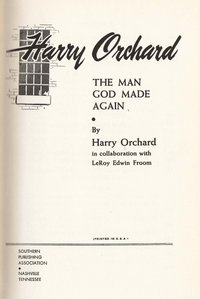





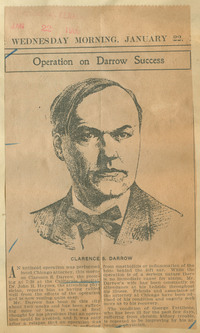

Nugent of Boise, Fred Miller of Spokane, Clarence Darrow of Chicago and Edmund F. Richardson of Denver in Boise. May 11, 1907. Courtesy of McCormick Library of Special Collections, Northwestern University Library.


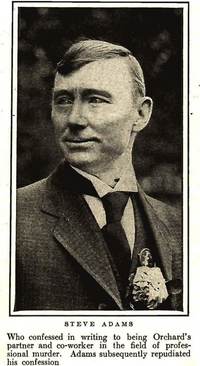
Adams was living in Oregon at the time and was later arrested. He was assured that he was only needed to corroborate Orchard's confession and he was taken to the Boise, Idaho penitentiary. McParland eventually got Adams to confess to some criminal activity which helped to corroborate at least some of Orchard's confession. Most importantly Adams confessed that he and Orchard had planted the explosives under the Independence depot which killed thirteen nonunion workers. One of Clarence Darrow's most significant early victories was getting an uncle of Adams's wife to persuade Steve Adams to repudiate his confession.





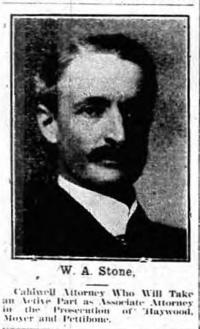

"We had already become rather well acquainted with Mr. and Mrs. Edgar Wilson. Mr. Wilson was the first Congressman from Idaho, one of the earliest settlers of the State, and one of the most respected. Then, and afterward, the Wilsons were our loyal friends, and did a great deal to make life more tolerable in Idaho; and later on, in Los Angeles, they proved as staunch and devoted as any friends that ever came into our lives."









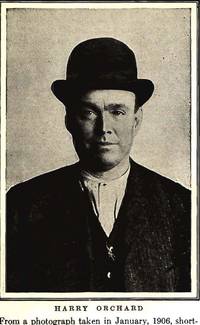

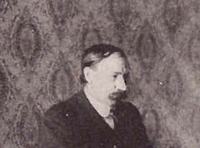
"Simpkins was dead, killed by the WFM to ensure he never informed on his co-conspirators; Simpkins had found sanctuary in Australia or Singapore; Simpkins was a Pinkerton plant, an agent provocateur sent my McParland to trigger the Steunenberg assassination as a means to exterminate the WFM's leaders." J. Anthony Lukas, Big Trouble: A Murder in a Small Western Town Sets Off a Struggle for the Soul of America 293 (1998).
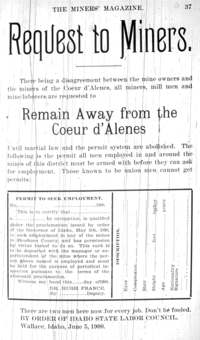
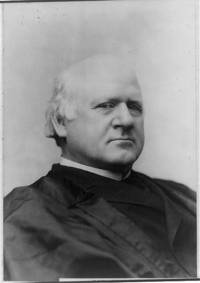






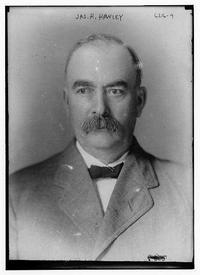

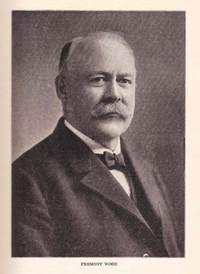
"Judge Wood . . . was not a popular man in Boise or in Idaho after the trial. He faced not only vilification by Governor Gooding, but the slander of widespread rumors that he had been bribed. He remained a district judge to conduct the Pettibone and Orchard trials, but left the bench shortly thereafter with his career virtually ruined. Public opinion in Idaho did not forgive or forget Wood's instructions to the Haywood jury, particularly after it became known that he believed that Orchard was telling the truth and that Haywood was guilty." David H. Grover, Debaters And Dynamiters: The Story of The Haywood Trial 291 (1964).








Photos



After Haywood, Moyer and Pettibone were arrested on February 17, 1906 and held pending trial, sharp differences between Haywood and Moyer began to get worse. Their animosity towards each other was exacerbated later in 1906 when a struggle broke out within the IWW between more moderate members and more radical members. Haywood sided with the radicals referred to as "revolutionists" and Moyer sided with the more moderates referred to as "reformists." Trautmann also sided with the revolutionists.
Around February 21, 1906 Clarence Darrow and William Trautmann met in Chicago. Trautmann informed Darrow that the IWW and organized labor wanted the accused to get the best legal defense they could and he asked Darrow if he would defend them. Darrow did not accept right away. On February 26 Darrow met with James A. Kirwan, a member of the WFM's executive committee, J.C. Williams, vice president of the Western Federation of Miners, and Edmund Richardson in Denver. It was reported after this meeting that Darrow agreed to help defend Haywood, Moyer and Pettibone as an associate counsel.

In 1908 a bomb destroyed Wells' Telluride home, but Wells survived. The assassination attempt was believed to be the work of the WFM. Wells had particular animosity for Vincent St. John (1876 - 1929), an American labor leader and a prominent leader of the Industrial Workers of the World (I.W.W.). Clarence Darrow defended Vincent St. John in 1918 when about 100 I.W.W. members including William D. Haywood were arrested, tried and convicted of disloyal acts against the government. Haywood was sentenced to 20 years in prison and St. John was sentenced to 10 years. Photo from History of Colorado,, edited by Wilbur Fiske Stone (1918).



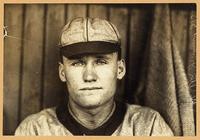






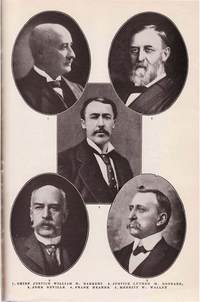







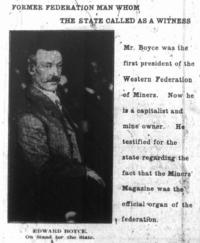




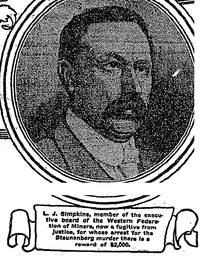












General Merriam's Negro Soldiers Refused to Allow Priests to Administer to Dying "Bull Pen" Victims. Where Innocent Men were Tortured to Death. From the Atlanta Journal. March 17, 1900."
During the 1899 Coeur d'Alene labor troubles, one of the main reasons the miners and their sympathizers deeply resented the imposition of military rule was the participation of the Twenty-fourth Infantry Regiment, a highly regarded unit with black troops under the command of white officers. During his testimony on the stand in his murder trial, William Haywood said "I was opposed to outrages that were perpetrated against the women there by the negro soldiers."


































